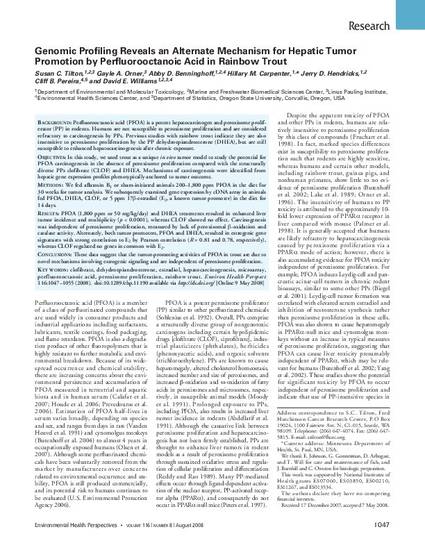
Background
Perfluorooctanoic acid (PFOA) is a potent hepatocarcinogen and peroxisome proliferator (PP) in rodents. Humans are not susceptible to peroxisome proliferation and are considered refractory to carcinogenesis by PPs. Previous studies with rainbow trout indicate they are also insensitive to peroxisome proliferation by the PP dehydroepiandrosterone (DHEA), but are still susceptible to enhanced hepatocarcinogenesis after chronic exposure. Objectives
In this study, we used trout as a unique in vivo tumor model to study the potential for PFOA carcinogenesis in the absence of peroxisome proliferation compared with the structurally diverse PPs clofibrate (CLOF) and DHEA. Mechanisms of carcinogenesis were identified from hepatic gene expression profiles phenotypically anchored to tumor outcome. Methods
We fed aflatoxin B1 or sham-initiated animals 200–1,800 ppm PFOA in the diet for 30 weeks for tumor analysis. We subsequently examined gene expression by cDNA array in animals fed PFOA, DHEA, CLOF, or 5 ppm 17β-estradiol (E2, a known tumor promoter) in the diet for 14 days. Results
PFOA (1,800 ppm or 50 mg/kg/day) and DHEA treatments resulted in enhanced liver tumor incidence and multiplicity (p < 0.0001), whereas CLOF showed no effect. Carcinogenesis was independent of peroxisome proliferation, measured by lack of peroxisomal β-oxidation and catalase activity. Alternately, both tumor promoters, PFOA and DHEA, resulted in estrogenic gene signatures with strong correlation to E2 by Pearson correlation (R = 0.81 and 0.78, respectively), whereas CLOF regulated no genes in common with E2. Conclusions
These data suggest that the tumor-promoting activities of PFOA in trout are due to novel mechanisms involving estrogenic signaling and are independent of peroxisome proliferation.

Originally published by the National Institute of Environmental Health Sciences (NIEHS). Publisher's PDF and HTML fulltext can be accessed through Environmental Health Perspectives. Abby Benninghoff was affiliated with Oregon State University at time of publication.
Note: This publication was selected as highlight article for this journal issue. Utah State has reproduced this publication with permission from the journal.